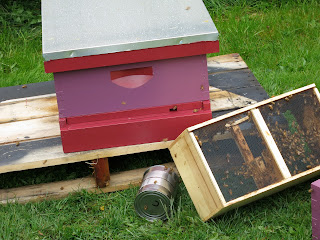First of all, spring means it's been a busy time in the garden. Here was an end-of-winter harvest for dinner one night, sometime back in early March. I had overwintered beets, arugula, kale, green onions, and also grown oyster mushrooms in the basement.
I pulled out the brassicas that were bolting, such as kale and brussel sprouts. But not before taking advantage of their little buds before they opened into flowers. I don't know why we don't eat these commonly, but they are really similar to broccoli raab and quite delicious. There are people who say you don't want to eat the leaves of kale and other plants after they bolt since they turn bitter, but I think you'd be hard-pressed to find any one who could taste the difference between bolted kale leaves sauteed in a dish.
Speaking of less-common veggies, I also harvested a bunch of stinging nettles. Once steamed, the leaves lose their sting and are incredibly nutritious, versatile, and tasty spring greens. I made pesto, and also a nettle-spinach spanakopita with a bunch of fresh mint from the garden.
Speaking of less-common veggies, I also harvested a bunch of stinging nettles. Once steamed, the leaves lose their sting and are incredibly nutritious, versatile, and tasty spring greens. I made pesto, and also a nettle-spinach spanakopita with a bunch of fresh mint from the garden.
Around the same time, the Smitten Kitchen blog had a recipe for very green and fresh Spring Vegetable Potstickers. I had never made potstickers before, but as she wrote, folding them is pretty intuitive and they turned out great.
A few weeks back I went a little crazy with rhubarb at the Ballard Farmer's Market, which left me wanting to explore new rhubarb dishes. Again from Smitten Kitchen, I found this fabulous recipe for Rhubarb Streusel Muffins which I made twice.
There was also Rhubarb-Apple Crisp, a nice change from the usual strawberries. The most unique thing I did with those stalks though was to add sugar, water, a vanilla bean, cinnamon stick, and cardamon pod, simmer and reduce it into a sauce. Then I strained the liquid off and added club soda and vanilla ice cream for a Rhubarb Float. The chunky remainder of the sauce went on yogurt. So simple, but such a good idea!
I'm almost ashamed to admit this, but I had no idea until this past month that Ballard has a handful of awesome nano breweries. I made up for lost time by visiting several, including NW Peaks, Reubens Brews, and Peddler Brewing Co. I had an amazing oak barrel aged saison at Hilliards.
Last but not least, I saw this pig going through a coffee drive-through.




























